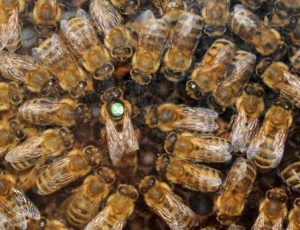Poetry and science may seem to have little in common, but they do share one trait: building from fragments. I’m collaborating with a wonderful poet, Renee Sarojini Saklikar, on the Honey, Hives and Poetry project, in which we’ve been reading together at events from her poems and my prose, and writing some new material in response to each other’s work.
As Renee puts it: “One of my poetry obsessions is the fragment. Each time I read from my long poems I select fragments, further reducing the pieces, a reductive process that speaks to me of possibility . . .”
Scientific research is simultaneously reductive while discovering meaning by repeatedly recombining small bits of information in different ways. Experiments resemble poems trimmed down to their simplest bytes, expressing the scientist’s hope that disparate data might assemble into the fullness of story, revealing objective truth considerably more profound than its constituent parts.
So it was that words became a line and eventually a poem as we unraveled the identity and function of the honeybee queen pheromone over close to two decades of research. My chemistry colleague, the late Keith Slessor, had become interested in the retinue of ten to twelve worker bees that surround the queen, licking and touching their antennae to her furiously for one to two minutes each. Our hypothesis was that they were picking up the queen’s pheromones and transmitting them throughout the nest.
We had made extracts from dead queens to use in identifying her chemical signature, but had no way of determining whether worker bees responded. One day, in frustration, one of our students put a dab of extract onto a glass pipette and thrust it into into a cage of bees, exclaiming, “Take that, you bloody bees.” To her surprise, they formed a retinue around the glass as if it were a queen.
We had found our bioassay, but it still took tens of thousands of assays excising, macerating, extracting, eluting and observing over two decades to identify nine compounds that work in a synergistic mix, attracting worker bees to attend their monarch. Each individual pheromone we identified represented another fragment that then had to be tested in combination with the growing number of other compounds, until eventually the full poem of the complex honeybee queen pheromone grew from its nine simple words.
It’s a thing of beauty, this multi-fragment queen pheromone, an elixir of elegant function, reminiscent of the elusive perfection captured in the best poetry, where snippets of language weave together into a whole much more compelling than its individual parts.
I imagine writing poetry is like that, a mental image of Renee at work in her writing laboratory, testing combinations of words together, rejecting innumerable linguistic dead ends until the etymological data tell her the poem is done.
It’s fragments coalescing into meaning, at the junction where science and poetry intersect on common ground.
(In memory of Keith Slessor, a poet in chemistry)
Comments welcome:
